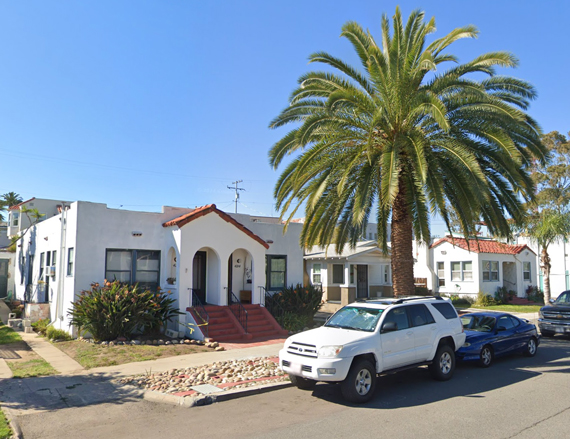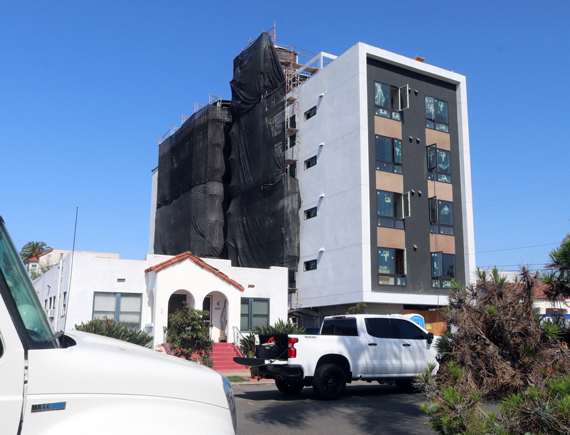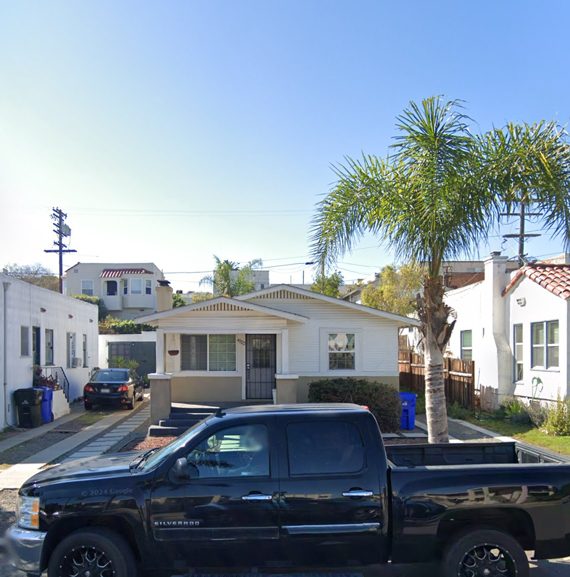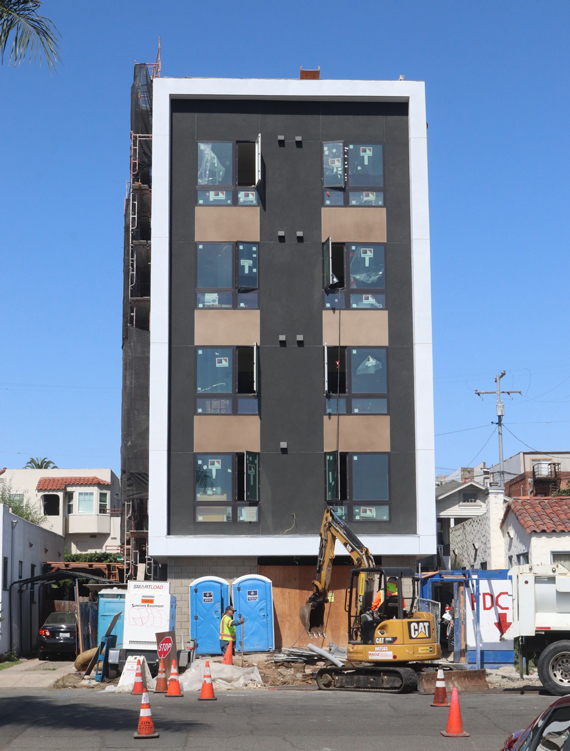|
Developers Driving Gentrification in San Diego
Shamefully, the City and YIMBYS Are Fully On Board
By Bruce Coons
SOHO Executive Director
September/October 2024
 |
 |
Left Angled Google streetview of 4222 Georgia Street (small Craftsman house in the middle) in North Park in February 2022; right same view August 2024. Photo courtesy Gregory May |
 |
 |
Top Google streetview of the front of 4222 Georgia Street in North Park in February 2022; bottom same view August 2024. Photo courtesy Gregory May |
The City of San Diego appears dead set on pursuing a disastrous course of gentrification that threatens permanent loss of truly affordable housing, leading potentially to the emergence of what has been termed an “indentured rental class.”
People trying to buy starter homes are being priced out of the market by developers who can buy single family properties and put multiple units on them. This new, legal scenario appears to be by design, to create a city and nation of renters, whose unchecked rent increases will be at the will of real estate developers, and forever exclude individuals and families from the prospect of home ownership.
Unless the runaway housing market stumbles or collapses, this dire threat will continue to decimate our historic neighborhoods. While thoughtful urban development can yield economic benefits, San Diego’s approach diverges by prioritizing new construction at any cost. This type of sanctioned profiteering comes at the steep cost of displacing long-time residents, altering neighborhood character, and significantly reducing the availability of actual affordable housing. Current policy will continue to produce almost exclusively market-rate housing.
Catering to developer profitability rather than community needs, San Diego decision makers are prioritizing market-rate housing over affordable options, exacerbating housing inequality for middle- and lower-income hopeful homeowners. The City's new growth plan proports to reverse racial segregation by changing zoning laws, but instead accelerates gentrification in historically marginalized areas.
The latest example of this trend is in Hillcrest, known as San Diego's "gayborhood.” The recently adopted "Plan Hillcrest" will displace and price out the LGBTQ+ community that revitalized the area decades ago.
The City is in fact accelerating the displacement of vulnerable communities and has kept no records on how many affordable units we have lost. The City Council recently heard testimony citing plummeting downtown Single-Room Occupancy (SROs) units. They once numbered 12,000; now there are only 3,000. Did these 9,000 lost rooms increase the homeless population now living in the same downtown streets?
The impact of these changes is also visible in areas like Logan Heights, where gentrification threatens not only housing, but also cultural heritage. Similar concerns exist in other historically diverse neighborhoods across San Diego.
Apparently indifferent to these residents are the YIMBYs, whose community groups receive major donations from the development industry. Follow the money and it's easy to see its targeted impact on state and local legislation. Thousands of families in San Diego are having their quality of life uprooted, with apartments as small as 442 square feet starting at $2,000.
“Many people don't mind paying the price [i.e. sky-high rent] to live in a small space if it means they get to live in paradise. San Diego kind of borders on a lifestyle market. We see people spending less time in apartments and [instead] going outside," Doug Ressler, manager of business intelligence at Yardi Matrix, a commercial real estate data and research firm, told CBS 8. "An apartment essentially becomes just a place to keep your bike," he added.
While YIMBYs may only use their living spaces to store their bikes, lower- and middle-income families want and require more. They want real homes.
The housing crisis has reduced the size of living spaces and increased rental rates, presenting a critical challenge to maintaining affordable housing and preserving community culture and character. This is no time for San Diego politicians to favor market-rate housing.
Through this biased approach, we have lost an estimated 10,000 to 20,000 units of Naturally Occurring Affordable Housing (NOAH), according to the California Housing Partnership's newest report. The affected NOAH properties are typically historic and older buildings that provide affordable rents without government subsidies. When these buildings are redeveloped into new, high-end rental housing, the affordable units are lost forever, exacerbating the housing crisis. The report's conclusion should alarm all of us: Without mission-driven nonprofits, like preservationist SOHO, and local government housing agencies' support and oversight, “NOAH properties will eventually become extinct in California, given the current rate of loss.”
Along with the common-sense tenets of historic preservation and protecting NOAH, another solution may lie in Community Land Trusts, which have proven to be a viable and effective strategy for stabilizing neighborhoods and keeping housing costs affordable. The Tierras Indígenas Community Land Trust in San Diego is doing just this, with the goals of keeping developers from forcing families out of their homes and safeguarding neighborhood cultural identity.
“This is really an opportunity to preserve our culture and our community," Tierras Indígenas board member Julie Corrales said. “Our mission is to preserve affordable housing, keep people from displacement, and create opportunities for low-income folks to enter into home ownership.”
The City of San Diego needs to adopt these same goals now.
The YIMBY Movement: Historic Preservation's Response
PlaceEconomics, a private firm specializing in the economic impacts of historic preservation, recently released a report titled The YIMBY Movement: Historic Preservation's Response. The report addresses the growing influence of the Yes in my Backyard (YIMBY) movement, which advocates for deregulation and a developer-led approach to address the affordable housing crisis.
Historic districts, despite making up only 2-6% of a city's land area, often offer the best examples of density, affordability, and diversity. The report highlights that these districts are denser, have higher population growth rates, and exhibit greater racial and income diversity compared to other areas.
Additionally, the report argues that the housing crisis stems not from a lack of new housing but from the loss of older units. Over the past 30 years, more than 8 million pre-1970 housing units have been demolished. These older homes are often naturally more affordable, typically costing 16% less than newer constructions. Rather than targeting historic districts, the report suggests focusing on rehabilitating older housing to enhance affordability.
Check out the full report from PlaceEconomics to learn more, including additional analysis and specific case studies.
BACK to the table of contents
|
2025
2024
2023
2022
2021
2020
2019
2018
2017
2016
2015
|







